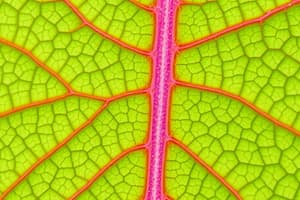Podcast
Questions and Answers
What is the primary function of the root system in plants?
What is the primary function of the root system in plants?
- Support for the leaves and flowers
- Storage and nutrient absorption (correct)
- Reproductive structures
- Photosynthesis
Which type of stem is characterized as soft and green?
Which type of stem is characterized as soft and green?
- Woody stem
- Taproot stem
- Fibrous stem
- Herbaceous stem (correct)
Which part of a flower is responsible for attracting pollinators?
Which part of a flower is responsible for attracting pollinators?
- Pistil
- Petals (correct)
- Stamen
- Sepals
What is a key characteristic of fleshy fruits?
What is a key characteristic of fleshy fruits?
Which leaf arrangement has three or more leaves per node arranged in a circle?
Which leaf arrangement has three or more leaves per node arranged in a circle?
What is the primary role of cotyledons in a seed?
What is the primary role of cotyledons in a seed?
In plant morphology, what distinguishes a taproot from fibrous roots?
In plant morphology, what distinguishes a taproot from fibrous roots?
Which growth form is typically characterized by thick, woody stems?
Which growth form is typically characterized by thick, woody stems?
Flashcards are hidden until you start studying
Study Notes
Morphology of Plants
Definition
- Morphology: The study of the form and structure of organisms, including plants.
Key Components
-
Roots
- Functions: Anchoring, nutrient and water absorption, storage.
- Types:
- Taproot: A single, thick root (e.g., carrots).
- Fibrous: Many thin roots (e.g., grasses).
-
Stems
- Functions: Support for leaves and flowers, transport of nutrients and water.
- Types:
- Herbaceous: Soft, green stems (e.g., tomato plants).
- Woody: Hard, thick stems (e.g., trees).
-
Leaves
- Functions: Primary site for photosynthesis, gas exchange.
- Structures:
- Blade: Flat part of the leaf.
- Petiole: Stalk that attaches leaf to stem.
- Types:
- Simple: Single blade.
- Compound: Multiple leaflets.
-
Flowers
- Functions: Reproductive structures.
- Parts:
- Petals: Attract pollinators.
- Sepals: Protect flower bud.
- Stamen: Male reproductive part (anther and filament).
- Pistil: Female reproductive part (stigma, style, ovary).
-
Fruits
- Functions: Protect seeds, aid in seed dispersal.
- Types:
- Fleshy: Soft and edible (e.g., apples).
- Dry: Hard or papery (e.g., nuts).
-
Seeds
- Functions: Contain and protect the embryo, provide food supply.
- Structure:
- Seed coat: Protective outer layer.
- Cotyledons: Seed leaves that provide nutrients.
- Embryo: Developing plant.
Growth Forms
- Herbaceous: Non-woody plants, typically annuals or perennials.
- Woody: Trees and shrubs with thick stems, typically perennial.
- Vines: Can be herbaceous or woody; climbing plants that require support.
Leaf Arrangement
- Alternate: One leaf per node, staggered along the stem.
- Opposite: Two leaves per node, directly across from each other.
- Whorled: Three or more leaves per node, arranged in a circle.
Adaptations
- Various plant structures may adapt to specific environments (e.g., succulents with thick leaves for water storage in arid climates).
Importance
- Understanding plant morphology is essential for botany, agriculture, ecology, and horticulture, influencing classification, cultivation, and conservation efforts.
Definition
- Morphology involves studying the form and structure of organisms, particularly plants.
Key Components
-
Roots
- Essential for anchoring the plant, absorbing nutrients/water, and storage.
- Types:
- Taproot: A single, thick root (e.g., carrots).
- Fibrous: Numerous thin roots (e.g., grasses).
-
Stems
- Provide support for leaves and flowers, and are crucial for nutrient and water transport.
- Types:
- Herbaceous: Soft, green stems (e.g., tomato plants).
- Woody: Hard, thick stems (e.g., trees).
-
Leaves
- Main site for photosynthesis and gas exchange.
- Structures:
- Blade: The flat portion of the leaf.
- Petiole: The stalk connecting the leaf to the stem.
- Types:
- Simple: Comprises a single blade.
- Compound: Consists of multiple leaflets.
-
Flowers
- Serve as the reproductive structures of plants.
- Parts:
- Petals: Function to attract pollinators.
- Sepals: Protect flower buds.
- Stamen: Male reproductive components (composed of anther and filament).
- Pistil: Female reproductive components (includes stigma, style, and ovary).
-
Fruits
- Protect seeds and assist in their dispersal.
- Types:
- Fleshy: Soft and edible (e.g., apples).
- Dry: Hard or papery (e.g., nuts).
-
Seeds
- Contain and protect the embryo, also providing a food supply.
- Structure:
- Seed coat: The outer protective layer.
- Cotyledons: Seed leaves that supply nutrients.
- Embryo: The developing plant inside the seed.
Growth Forms
- Herbaceous: Typically non-woody and can be annuals or perennials.
- Woody: Includes trees and shrubs with thick stems, generally perennial.
- Vines: Can be either herbaceous or woody; they are climbing plants needing support.
Leaf Arrangement
- Alternate: A single leaf at each node, staggered along the stem.
- Opposite: Two leaves at each node, directly facing each other.
- Whorled: Three or more leaves at each node, arranged in a circular formation.
Adaptations
- Plants can adapt their structures to specific environments, such as succulents with thick leaves for water retention in dry climates.
Importance
- Understanding plant morphology is crucial for fields like botany, agriculture, ecology, and horticulture, affecting classification, cultivation techniques, and conservation strategies.
Studying That Suits You
Use AI to generate personalized quizzes and flashcards to suit your learning preferences.



